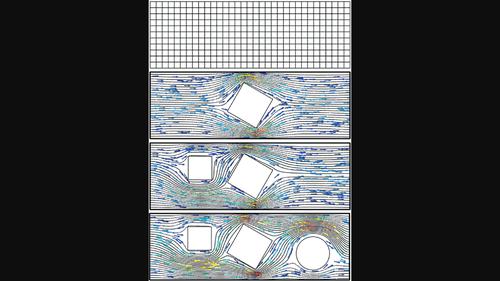当前位置:
X-MOL 学术
›
Int. J. Numer. Methods Fluids
›
论文详情
Our official English website, www.x-mol.net, welcomes your feedback! (Note: you will need to create a separate account there.)
Moving least-squares aided finite element method: A powerful means to predict flow fields in the presence of a solid part
International Journal for Numerical Methods in Fluids ( IF 1.8 ) Pub Date : 2024-02-11 , DOI: 10.1002/fld.5261 Mehdi Mostafaiyan 1, 2 , Sven Wießner 1, 2 , Gert Heinrich 3
International Journal for Numerical Methods in Fluids ( IF 1.8 ) Pub Date : 2024-02-11 , DOI: 10.1002/fld.5261 Mehdi Mostafaiyan 1, 2 , Sven Wießner 1, 2 , Gert Heinrich 3
Affiliation

|
With the assistance of the moving least-squares (MLS) interpolation functions, a two-dimensional finite element code is developed to consider the effects of a stationary or moving solid body in a flow domain. At the same time, the mesh or grid is independent of the shape of the solid body. We achieve this goal in two steps. In the first step, we use MLS interpolants to enhance the pressure (P) and velocity (V) shape functions. By this means, we capture different discontinuities in a flow domain. In our previous publications, we have named this technique the PVMLS method (pressure and velocity shape functions enhanced by the MLS interpolants) and described it thoroughly. In the second step, we modify the PVMLS method (the M-PVMLS method) to consider the effect of a solid part(s) in a flow domain. To evaluate the new method's performance, we compare the results of the M-PVMLS method with a finite element code that uses boundary-fitted meshes.
中文翻译:

移动最小二乘辅助有限元法:预测存在实体零件时流场的强大方法
在移动最小二乘 (MLS) 插值函数的帮助下,开发了二维有限元代码来考虑流域中静止或移动固体的影响。同时,网格或网格与实体的形状无关。我们分两步实现这一目标。第一步,我们使用 MLS 插值来增强压力 (P) 和速度 (V) 形函数。通过这种方式,我们捕获了流域中的不同不连续性。在我们之前的出版物中,我们将此技术命名为 PVMLS 方法(由 MLS 插值增强的压力和速度形状函数)并对其进行了全面描述。在第二步中,我们修改 PVMLS 方法(M-PVMLS 方法)以考虑流域中实体零件的影响。为了评估新方法的性能,我们将 M-PVMLS 方法的结果与使用边界拟合网格的有限元代码进行比较。
更新日期:2024-02-11
中文翻译:

移动最小二乘辅助有限元法:预测存在实体零件时流场的强大方法
在移动最小二乘 (MLS) 插值函数的帮助下,开发了二维有限元代码来考虑流域中静止或移动固体的影响。同时,网格或网格与实体的形状无关。我们分两步实现这一目标。第一步,我们使用 MLS 插值来增强压力 (P) 和速度 (V) 形函数。通过这种方式,我们捕获了流域中的不同不连续性。在我们之前的出版物中,我们将此技术命名为 PVMLS 方法(由 MLS 插值增强的压力和速度形状函数)并对其进行了全面描述。在第二步中,我们修改 PVMLS 方法(M-PVMLS 方法)以考虑流域中实体零件的影响。为了评估新方法的性能,我们将 M-PVMLS 方法的结果与使用边界拟合网格的有限元代码进行比较。



























 京公网安备 11010802027423号
京公网安备 11010802027423号